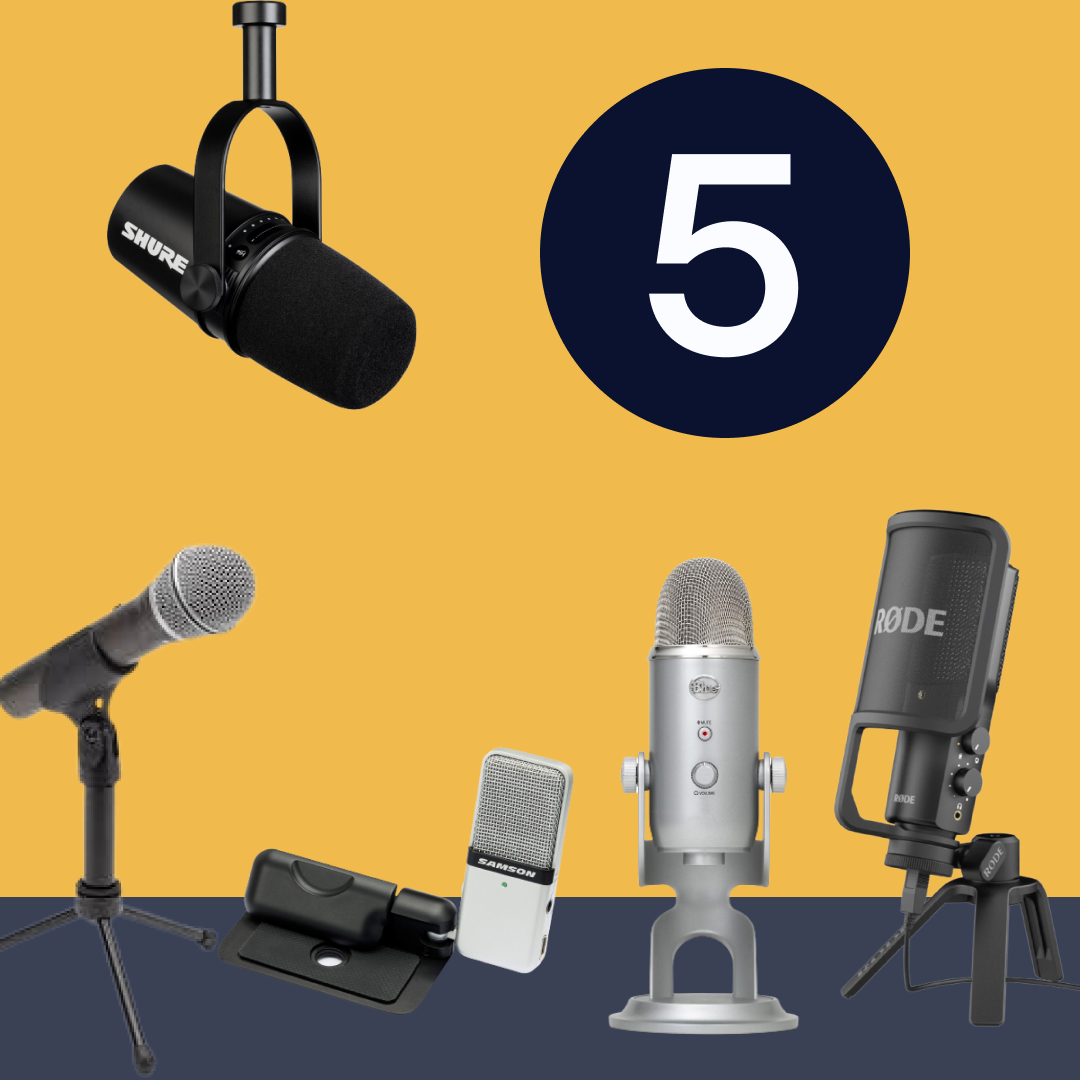If one of the reasons you got into podcasting was because you liked the idea of speaking authoritatively into a microphone, we get it.
And that dream has never been more achievable: The best USB microphones for podcasting are better than ever at capturing your voice at a high quality, without requiring a lot of technical knowledge.
As with everything audio, it’s possible to get very geeky about microphones. At the same time, the increase in amateur podcasters has forced microphone manufacturers to up their game at the lower level of the budget spectrum. Many good quality podcasting USB mics are under $200. And if you want to get into the weeds and dig around with settings, you can spend far more.
Here’s how to get started choosing a USB mic for podcasting:
What specifications to consider in a USB microphone for podcasting
Accessories for USB microphones
The 5 best USB microphones for podcasting
Why Choose a USB Microphone?
Today’s USB mics are not the same ones you used to plug into Windows ‘97. As more people have started recording podcasts and other audio projects, the quality of USB mics has improved. The models you can buy today are definitely good enough to help you bring your podcast to life.
USB vs. XLR podcast microphone
The other family of podcasting microphone are XLR mics, which you have to plug into a mixer that then connects to your computer. XLR mics are the kind of microphone you see at live events.
You can use an XLR microphone to record a podcast: but with so many accessible, affordable and excellent USB mics, you don’t need to.
Think of it as the difference between the cake mixer you use at home when you feel a sudden craving for homemade cookies, and the mixer a professional baker would use. If you have the money, there’s no reason you can’t buy the expensive version: but you won’t even have the expertise to use it yet, and you’ll get what you need from the less-expensive option.
Plus, just to shake things up a bit, some USB microphones have ports that allow you to plug them into mixers and use them as XLR mics. So if you see yourself as the podcast version of a patisserie chef, and you want a podcasting microphone to match those ambitions, consider one of these as a first step.
Specifications to Consider When Choosing a USB Microphone For Podcasting
Your best USB microphone for podcasting depends on certain key factors, including the environment you’re working in, the kind of show you’re making, and the nature of the sound you’re hoping to produce. Here are four specifications to consider.
1. Dynamic vs. condenser podcast microphone
There are two main types of USB microphone: dynamic mics and condenser microphones. There’s some debate over which type is the best USB microphone for podcasting, but really it’s a personal decision that depends on your circumstances
If you’re working in a quiet, soundproof environment, you could consider condenser mics. Condenser microphones are more sensitive, which means they pick up quieter sounds and higher frequencies more readily than dynamic mics.
On the bright side, this means your vocals come out with a crisper, clearer tone. On the down side, it means background noise is more likely to come through. If you can control that and guarantee sound-proofing, the quality of the sound you get with a condenser microphone makes it a more tempting choice. But if you’re stuck in a noisy environment, you’d be better off with a dynamic mic.
Because the nature of remote podcast recording means dealing with background noise, we usually recommend dynamic USB mics for podcasting. Since these microphones aren’t as good at picking up sound as condenser microphones, you will probably have to sit pretty close, and you’ll need multiple microphones if you’re recording with more than one person. The tone will also come out slightly duller. However, you won’t have to worry about background noise to the same degree.
🎙️ TL;DR: If you’re recording somewhere quiet, choose condenser microphones for the more polished sound. If not, a USB dynamic microphone is better for podcasting.
2. Polar patterns
No, we’re not talking about snow angels. In the context of USB microphones, polar patterns — or pickup patterns — refer to the area your microphone picks up the most sound from.
For example, a cardioid mic will concentrate on sound coming from the front, pick up a little from the side, and won’t pick up sound from behind. This is why live performers typically use cardioid mics: you hear all of their voice and none of the audience.
The cardioid pickup pattern is also a good choice for podcasting microphones, since it captures your voice from the front while reducing the amount of background noise you’ll get from the other side of the microphone.
In contrast, USB mics with omnidirectional pickup patterns capture sound all around. Although in theory that could make them useful if there are multiple people recording in the same room, or if you like ambience, in practice, it means you get a lot more background noise.
🎙️ TL;DR: Most of the time, a microphone that records in a cardioid pickup pattern is the best podcasting microphone, compared to an omnidirectional microphone.
3. Phantom power
Although it sounds like a “Ghostbusters” sequel (for the Millennials and Gen Xers among us), phantom power is much more down-to-Earth.
This is just a fancy way of saying that your microphone needs an external power source to run. This is more common in condenser mics. However, unlike their XLR counterparts, many USB condenser microphones can draw power directly from your computer.
🎙️ TL;DR Check the power source.
4. Headphone latency
Headphones are another important piece of podcasting equipment, as they allow you to hear the audio you’re recording.
Headphone latency, a type of audio latency, refers to the time it takes sound to travel from the microphone to your ears, through your headphone output. If you’ve ever sat through a phone or video call with a delay, you know how disconcerting that little gap between speaking and hearing your own voice can be.
When you’re shopping for USB mics, look for models with headphone jacks, so you can plug your headphones in. Specifically, look for a zero latency headphone jack, which enables you to listen to the audio from your microphone in real time.
🎙️ TL;DR: A zero latency headphone jack means no annoying delay between speaking and hearing.
Accessories for USB Microphones
The best USB podcast microphones make recording a great sound for your show easier than it’s ever been. However, there are a couple of accessories that can make you sound even better.
Pop filters
Whatever kind of microphone you buy, you’ll also need a pop filter. Usually this is some kind of screen or cover that goes around a microphone and softens the sound of noises called “plosives” — “Bs” and “Ps.” These sound like little pops when picked up on a microphone, and aren’t very fun to listen to. Pop filters, as the name suggests, filter these out. Some USB microphones even have pop filters built into them, and others are sold with screens or covers.
A mic stand
Unless you like to pretend that you’re onstage when you’re recording your podcast in your closet, you probably don’t want to hold your microphone for the entire session.
Having an adjustable stand frees you up to concentrate on what you’re saying, and keeps the microphone in one place, so you don’t have to worry about your vocals getting louder and quieter as you move further away or closer.
Most microphones will come with a mic stand, usually a desktop kind. However, you can also buy models that attach to a wall, known as a boom arm.
The 5 Best USB Microphones for Podcasting
Now that you know what you’re looking for, here are five examples of USB microphones that are great for podcasting.
The travel companion: Samson Go
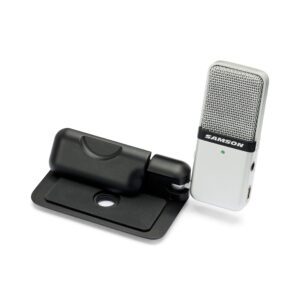
Price (pre-tax): $49.99
Element type: Condenser
Polar pattern: Cardioid and omnidirectional
The low-cost, high sound quality contender: Samson Q2U
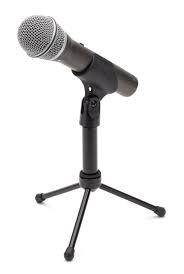
The microphone comes with a USB cable, XLR cable, tripod stand and extender, and a cover that acts like a pop filter. It’s not as fancy as some of the other options, but for $70, it’s definitely a solid choice if you’re testing the podcasting waters and want to sound like a pro.
Price (pre-tax): $69.99
Element type: Dynamic
Polar pattern: Cardioid
The favorite: Blue Yeti USB Mic
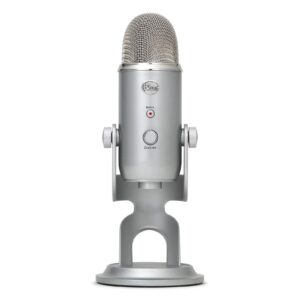
It comes with several built-in features that beat the Samsung Q2U and allow for more customization of sound. For example, a mute button complete with a light to tell you when the mic is on, a dial to control volume on your headphones, and a dial to control gain (basically the amplification level of your microphone.) You can also choose between different polar patterns, depending on the type of sound you’re trying to pick up.
With all that said, this is a condenser mic. As we know by now, that means that unless you have a perfectly silent room and are able to sit completely still, you’re going to pick up ambient noise. If you’ve decided you’re OK with that if it means getting more depth, the Blue Yeti is less expensive than other condenser mics, and has earned a strong fanbase in the podcasting world.
Price (pre-tax): $129.99
Element type: Condenser
Polar pattern: Cardioid, omnidirectional and bidirectional (sound picked up from front and back)
The up-and-comer: RØDE NT-USB
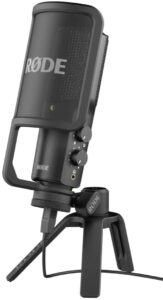
For example, it has a headphone jack and zero headphone latency, with dials to adjust the mix in real time, and you can connect it to an iPad with a USB camera adapter. It also comes with a pop filter already attached, so you can get started with minimum setup time.
Price (pre-tax): $169.00
Element type: Dynamic
Polar pattern: Cardioid
The little brother: Shure MV7
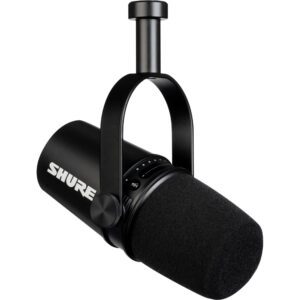
Similarly, the Shure MV7 is staking its claim as the USB microphone for podcasters who want professional quality sound without the professional-grade pricing.
It is a step up price-wise from the previous options, but with that comes more opportunities to play around with the sound quality during recording and in post-production. This is really easy through the ShurePlus MOTIV app, which is free for iOS and Android users. If you want the quality without the fuss, there’s also an auto mode on the app that will set the levels for you.
Like the Q2U, the MV7 can also plug into a mixer via an XLR cable. However, it doesn’t come with a stand, so you’ll have to buy one separately.
Price (pre-tax): $249.00
Element type: Dynamic
Polar pattern: Cardioid
Final Thoughts on Choosing a USB Microphone For Podcasting
With so many USB mics available now — and at price ranges for most budgets — you can get good quality audio with as much or as little effort as you’re willing to put in.
Zachariah Moreno is the co-founder, CEO, & CTO of SquadCast. He is also a podcaster, author, developer, and designer. He and his team are on a mission to amplify collaboration.
